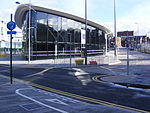Rochdale Pioneers Museum
Buildings and structures in RochdaleCo-operatives in EnglandCooperative movementCulture in RochdaleFood museums in the United Kingdom ... and 5 more
Former shops in EnglandHistory museums in Greater ManchesterHistory of RochdaleTourist attractions in the Metropolitan Borough of RochdaleUse British English from August 2015

The Rochdale Pioneers Museum is housed in the building where the Rochdale Equitable Pioneers Society started trading on 21 December 1844. The museum is regarded as the birthplace of the modern co-operative movement. It is located in Rochdale, Greater Manchester, England. The museum includes a recreation of the original shop, containing its rudimentary furniture, scales, items that were sold at the store, etc. Moreover, the museum transmits the influence of the co-operative movement on issues such as women's rights, poverty, education, fair trade and social reform. The museum is owned by the Co-operative Heritage Trust and managed by the Co-operative College.
Excerpt from the Wikipedia article Rochdale Pioneers Museum (License: CC BY-SA 3.0, Authors, Images).Rochdale Pioneers Museum
Toad Lane,
Geographical coordinates (GPS) Address Website Nearby Places Show on map
Geographical coordinates (GPS)
| Latitude | Longitude |
|---|---|
| N 53.6187 ° | E -2.15943 ° |
Address
The Baum
Toad Lane 33-37
OL12 0NU , Deeplish
England, United Kingdom
Open on Google Maps









